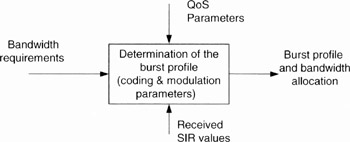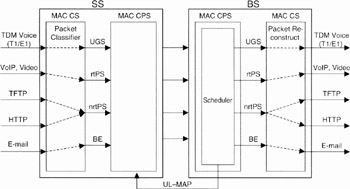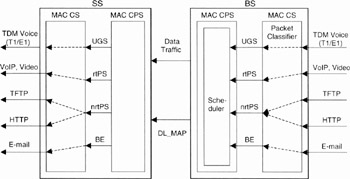11.4 Scheduling and Deployment of Services Over WiMAX
11.4 Scheduling and Deployment of Services Over WiMAX
11.4.1 The Scheduler is in the BS!
As already mentioned in this book, two topologies are defined: Point to MultiPoint (PMP) and Mesh. In the PMP mode, the network operates with a central BS and probably with a sectorised antenna that is capable of handling multiple independent sectors simultaneously. WiMAX/802.16 uses the PMP centralised MAC architecture where the BS scheduler controls all the system parameters (radio interface). It is the role of the BS scheduler to determine the burst profile and the transmission periods for each connection; the choice of the coding and modulation parameters are decisions that are taken by the BS scheduler according to the quality of the link and the network load and demand. Therefore, the BS scheduler must permanently monitor the received CINR values (of the different links) and then determine the bandwidth requirements of each station taking into consideration the service class for this connection and the quantity of traffic required. Figure 11.11 shows the BS scheduler operation.

Figure 11.11: The BS decides for bandwidth and burst profile allocations according to many entry parameters
By specifying a scheduling service and its associated QoS parameters, the BS scheduler can anticipate the throughput and latency needs of the uplink traffic. This is a mandatory operation in determining the appropriate burst profile for each connection. The BS may transmit without having to coordinate with other BSs, except possibly for the Time Division Duplexing (TDD) mode, which may divide time into uplink and downlink transmission periods common for different BSs.
Based on the uplink requests and taking into account QoS parameters and scheduling services priorities, the BS scheduler decides for uplink allocations. These decisions are transmitted to the SSs through the UL-MAP MAC management message. Figure 11.12 shows the BS scheduler operation for the uplink. The BS scheduler also decides for the downlink and transmits the decision using the DL-MAP MAC management message. Figure 11.13 shows the BS scheduler operation for the downlink.

Figure 11.12: BS scheduler operation for the uplink [5]

Figure 11.13: BS scheduler operation for the downlink [5]
There is also a scheduler present in the subscriber station (SS). The role of this scheduler is to classify all the incoming packets into the SS different connections.
The standard does not define a scheduling algorithm that must be used. Any of the known scheduling algorithms can be used: Round Robin, Weighted Round Robin, Weighted Fair Queuing and probably other known or to be defined scheduling algorithms. New scheduling algorithms are already being proposed specifically for WIMAX/802.16 scheduling in the literature.
11.4.2 Scheduling of the Different Transmission Services
Each SS to BS (uplink) connection is assigned a scheduling service type as part of its creation. When packets are classified in the Convergence Sublayer (CS), the connection into which they are placed is chosen based on the type of QoS guarantees that are required by the application (see Figures 11.12 and 11.13).
Although the standard gives all the details about the different classes of QoS and the methods of bandwidth allocation, the details of scheduling and reservation management are left unstandardised and are then left for vendors and operators. In Table 11.5 the scheduling service type is given that can be used for some classical services. Some of these services are mentioned in the standard.
| Application | Expected class of QoS | Explicitly indicated by the standard |
|---|---|---|
| Tl/El | UGS | Yes |
| VoIP without silence suppression | UGS | Yes |
| VoIP with silence suppression | ertPS | Yes |
| MPEG | rtPS | Yes |
| FTP | nrtPS | Yes |
| TFTP | nrtPS | No |
| HTTP | nrtPS | No |
| | BE | No |
[5]Agis, A. et al., Global, interoperable broadband wireless networks: extending WiMAX technology to mobility. Intel Technology Journal, August 2004.
EAN: 2147483647
Pages: 124